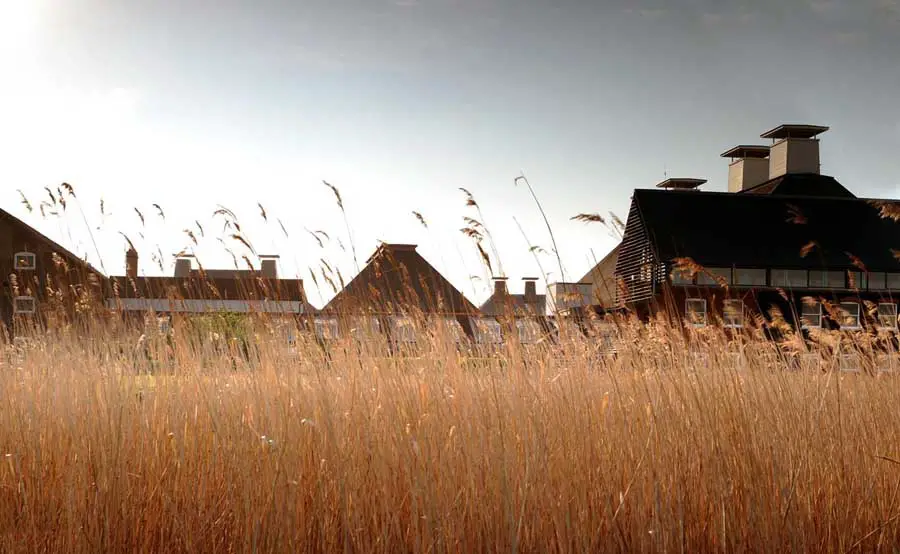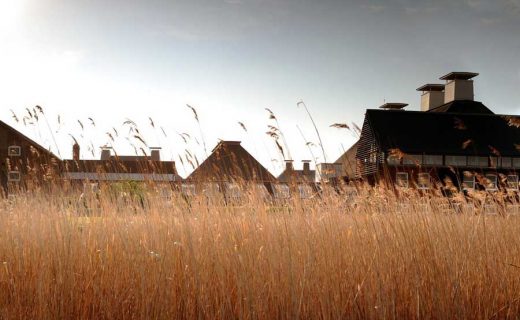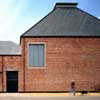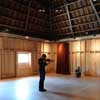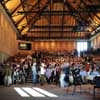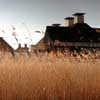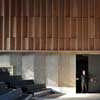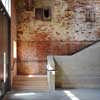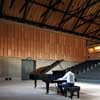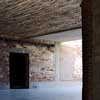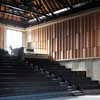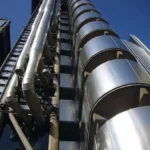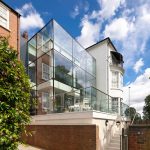Snape Maltings Buildings, Aldeburgh Music, Suffolk Architecture Photos, News, Design Project Images
Snape Maltings Building
Campus Architecture Development in Suffolk design by Haworth Tompkins, England, UK
25 Jan 2016
Derek Sugden Engineer
Derek Sugden Engineer, Structural Engineer and Acoustician
Derek Sugden Engineer obiturary in The Guardian, 25 Jan 2016
The structural engineer and acoustician who worked on the Snape Maltings concert hall and the new opera house at Glyndebourne has passed away.
Snape Maltings, the home of the annual Aldeburgh festival in Suffolk. Derek Sugden oversaw the work on the innovative concert hall, which was opened to much acclaim in 1967, reports The Guardian.
When, in 1963, with Arup Associates, Ove Arup finally realised his idea for an architectural practice composed of the whole range of building design professions, he chose the engineer Derek Sugden, who has died aged 91, as one of the partners. Derek went on to found Arup Acoustics, and to work on such acclaimed projects as the Snape Maltings concert hall in Suffolk; the Buxton and Glyndebourne opera houses; and the Theatre Royal, Glasgow.
Derek Sugden Engineer – obiturary in The Guardian, 25 Jan 2016
Snape Maltings Building News
Campus Buildings incl. Britten Studio + Jerwood Kiln Studio
Date built: 2009
Design: Haworth Tompkins
15 Jun 2009
Photographs : Philip Vile
Aldeburgh Music’s new creative campus at Snape Maltings opened to the public on May 9th. The project, part of a phased development of grade 2 listed 19th century maltings buildings at the edge of the Suffolk marshes, brings a range of derelict granaries and kilns into use as rehearsal and occasional public performance spaces grouped around a communal foyer. The centrepiece of the project is a new build orchestral rehearsal room, the Britten Studio, designed to complement the nearby concert hall (by Arup Associates, completed in 1970).
The rehearsal room incorporates retractable seating for 350, enabling it to be used as a public venue. A second space, the Jerwood Kiln Studio, was converted from a derelict kiln and can also accommodate public performances when required. The central foyer and technical get in was formed from an existing granary sandwiched between older structures, its eccentric timber roof adapted and a new concrete mezzanine installed.
The project builds on Haworth Tompkins’ past work with performance space in existing buildings such as the redevelopment of London’s Royal Court theatre and the Young Vic (runner up for the 2007 RIBA Stirling Prize). The brief, for flexible and creative workspace, was similar to the National Theatre Studio in London, where Haworth Tompkins provided rehearsal, residency and research accommodation for theatre practitioners.
Musicians are drawn to Snape Maltings’ unique sense of place, a combination of the austere industrial architecture and the wide, almost abstract landscape of the marshes. The newly renovated buildings seek to capture that sense of place, drawing on the surviving texture of the derelict buildings and making reference to the salty, astringent quality of the coastal landscape.
The exposed, graded aggregate concrete walls of the Britten Studio, for example, are designed to recall the shingle beach at Aldeburgh, whilst the pale chestnut strip ceilings in the foyer refer both to the old lath and plaster walls found on site and to the undulating reed beds that surround the building. Both of these devices are primarily designed to establish optimal acoustic conditions.
Materials used throughout the scheme were salvaged and recycled wherever possible, both to maintain the sense of history within the building and to reduce the embodied energy of the project. Agricultural roofing sheet and manmade slates (laid upside down to avoid an over polished finish) are used for economy but also to maintain a simple, unadorned aesthetic.
Daylight is maximised throughout the scheme to maintain contact with the outside world during rehearsal and to reduce energy costs. Dual lighting systems (for rehearsal and performance) are incorporated to minimise energy usage.
The technical challenges of the project were considerable: an acoustic specification to recording standards required sophisticated double skin isolation and very heavy roof construction, extremely quiet ventilation systems and specialised glazing; the rehearsal and performance use of the two principal spaces required a variable acoustic, achieved with large retractable drapes and banners along with angled walls and perforated timber bass absorbency panels; a sophisticated technical infrastructure allows music, opera, video and crossover work to be developed and performed; the risk of flooding due to high tides required the use of waterproof concrete substructure and robust finishes at ground floor level.
The next phase of the work, the Dovecot Studio, is almost complete. Situated at the symbolic threshold of the maltings and the marsh, a welded cor-ten steel building has been fabricated next to the brick ruins of a former dovecot. On completion it will be craned into the ruins to provide a small studio for musicians visual artists and writers. Subsequent phases will include an artists cafe and green room facing out over the marsh.
Director Steve Tompkins said:
“Over the four years of working here we’ve fallen in love with the maltings, where that extraordinarily powerful sense of place has driven all of our design decisions from the roof forms to the ceiling finishes. I hope we’ve designed a building that reinforces that sense of place and gives artists a powerful, responsive environment to engage with and in which to develop and perform their work”.
Haworth Tompkins has established a reputation as one of the UKs leading architectural practices for the arts. Founded in 1991 by Graham Haworth and Steve Tompkins, the 35 strong London practice has completed many award-winning arts projects including the Oxford North Wall arts centre, the Egg childrens theatre in Bath, London’s Royal Court, Young Vic, Regents Park, Almeida Gainsborough studios and Almeida Kings Cross theatres, the Hayward Gallery and the National Theatre Studio.
They are currently working on a new campus for the Royal College of Art and projects for the new Kings Schools music school in Birmingham, the Liverpool Everyman and Playhouse theatres, the Haunch of Venison Gallery, the Battersea Arts Centre (BAC) and the Bush theatre. Haworth Tompkins recently won the major commission to renovate the National Theatre on the South Bank.
The practice does not only specialise in arts projects. Other commissions include major buildings for Coin St Community Builders, the Peabody Trust, the London Library, Grosvenor Estates and Birmingham Schools for the Future.
Snape Maltings Campus – Design Team
Architects: Haworth Tompkins
Acoustic consultant: Arup Acoustics
Theatre consultant: Charcoalblue
Structural engineer: Price and Myers
Environmental engineer: Ernest Griffiths
Cost consultant: Davis Langdon
CDM Coordinator PFB Construction Management Services Limited
Client representative: Applied Solutions
Access Consultant Babel Limited
Contractor: Haymills
Address: Snape Maltings, Suffolk, IP17 1SP
Completion: May 2009
Construction budget: £5.5m (phase 1)
Photographer: Philip Vile
Snape Maltings Campus Building images / information from Haworth Tompkins
Snape Maltings Concert Hall : Arup Information
Location: Snape Maltings, Suffolk, IP17 1SP, England, UK
Suffolk Buildings
Suffolk Building Designs – selection:
John Lyall Architects
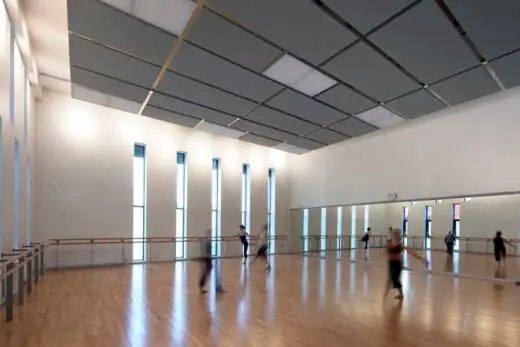
photograph : Morley von Sternberg
The Jerwood DanceHouse
Dune House, Thorpeness
Architects:Jarmund/Vigsnæs Architects
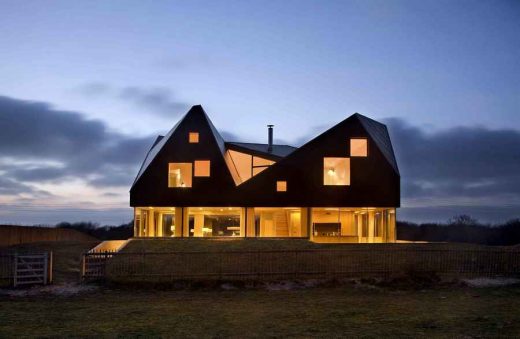
image from Living Architecture
Dune House
Dow Jones Architects
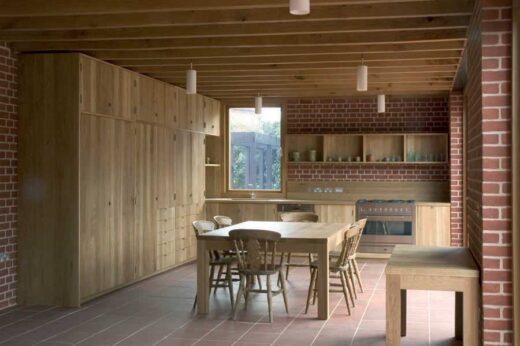
image from architects practice
Walberswick Suffolk property
English Architecture
Royal College of Art Battersea – also by Haworth Tompkins
Comments / photos for the Snape Maltings Building England page welcome

